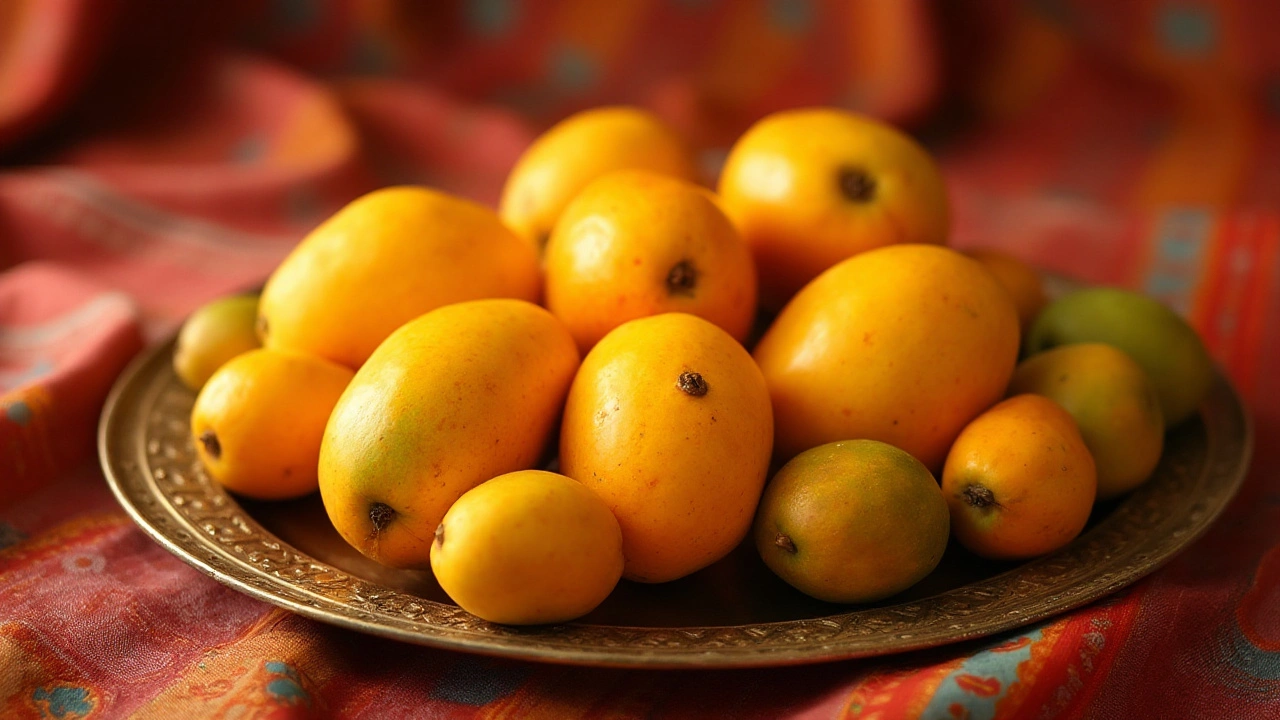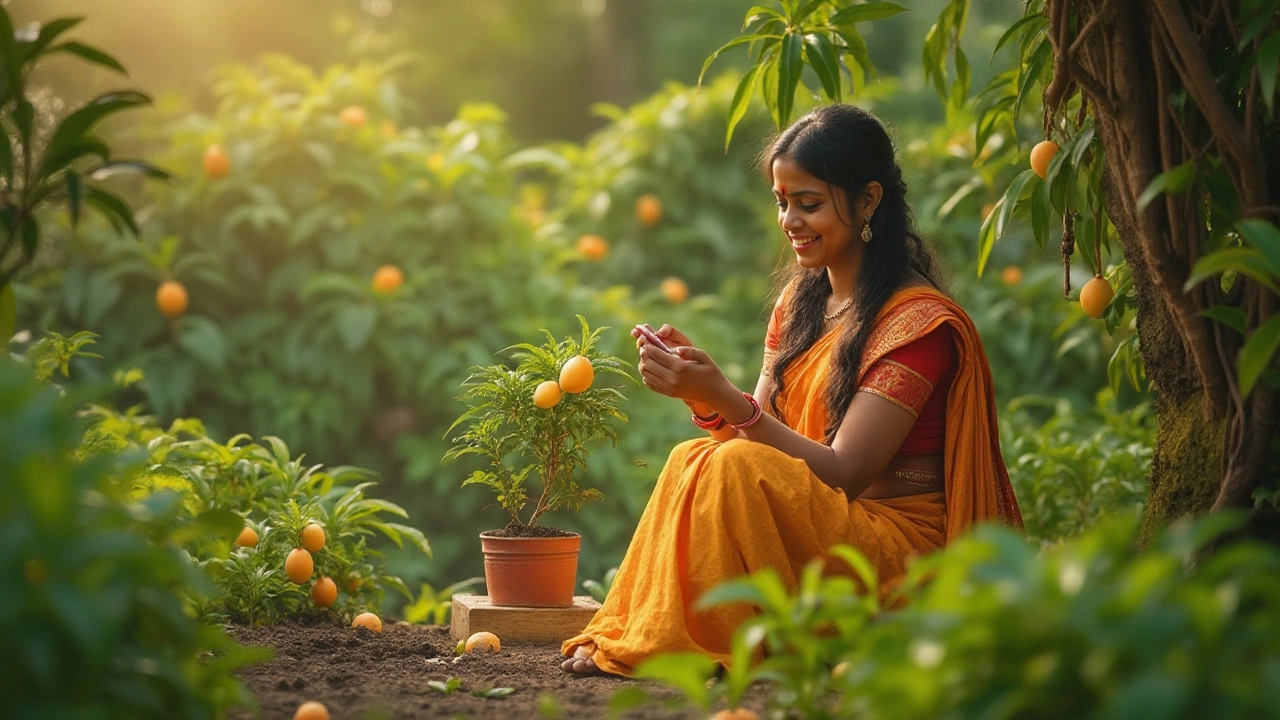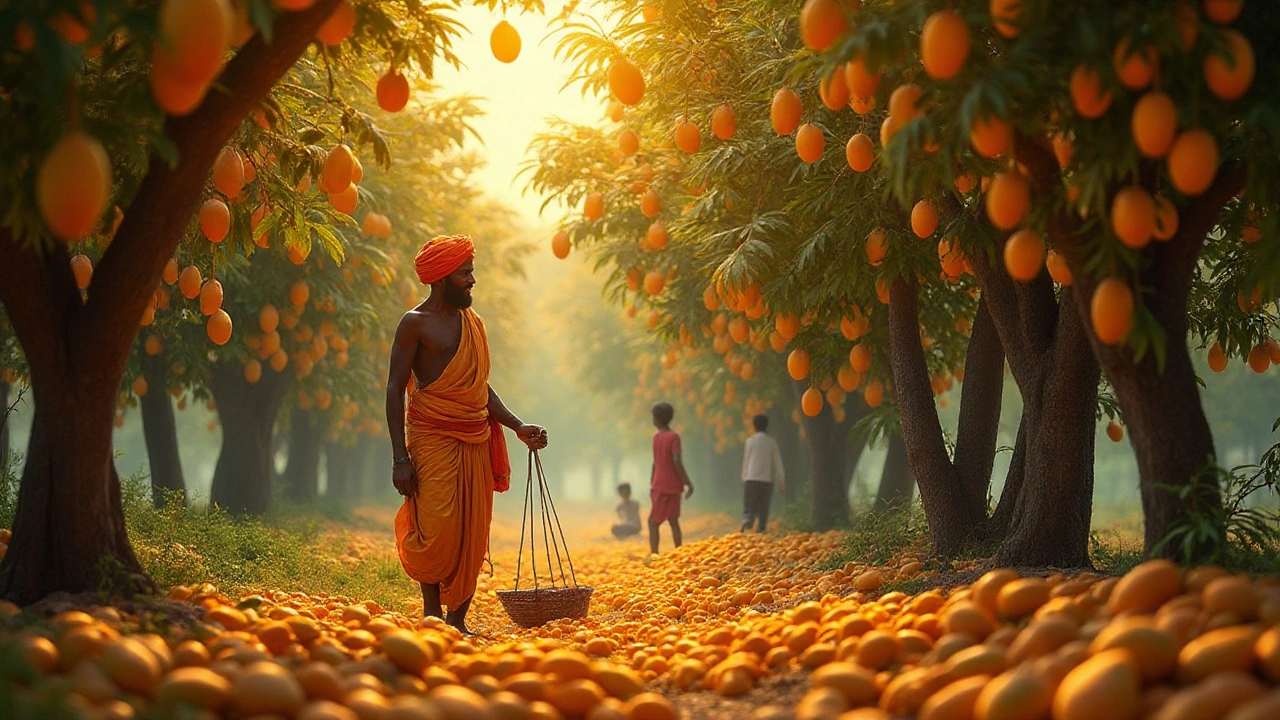The mango, with its rich taste and vibrant aroma, is not just a fruit in India—it's a way of life. As the national fruit, it holds a special place in society both culturally and economically. Its golden hues are celebrated in art, literature, and folklore, earning it a crown as the 'King of Fruits'. From the bustling markets of Mumbai to the traditional homes in Kerala, mangoes paint the season with their luscious presence.
Diving into the depths of its significance, this article takes you on a flavorful journey through history, cultivation, and the pivotal role mangoes play in Indian traditions. Whether you're a gardening enthusiast trying to nurture your first mango tree or a curious mind deciphering its cultural impact, this read promises insights and tips to unveil the charm of mangoes in India.
- The Mystical Journey of Mango in Indian Culture
- Varieties of Mangoes Found in India
- Benefits and Nutritional Values of Mangoes
- Gardening Tips: Growing Mangoes at Home
- Mango Rituals and Festivals in India
- Challenges and Solutions in Mango Cultivation
The Mystical Journey of Mango in Indian Culture
In India, few things are as cherished as the mango, a fruit whose origins grace centuries-old legends and colorful tales. The journey of India's national fruit is as vibrant as its taste, with deep roots in the ancient texts and revered traditions. The mango has been immortalized in the Sanskrit literature of ancient India, where it is called 'Amra'—a fruit symbolizing life and fertility. Revered as one of the most important and oldest fruits in India's gastronomic culture, the mango first blossomed in the wild forests of northeast India, Bangladesh, and Myanmar over 5,000 years ago.
Through time, the thirst for mango spread beyond the Indian subcontinent, carried by traders who were captivated by its succulent allure. Travelers too played a key role. The admiration of the mango reached the courts of the Mughal Empire, where emperors like Akbar cultivated large mango orchards. One such famed garden near Darbhanga in Bihar—built by Akbar—was said to have contained over 100,000 mango trees, an extraordinary testament to the love for this fruit. The influence of the mango transcended culinary arts, earning a place in religious practices and local folklore. The leaves and fruit symbolize purity and prosperity, often used in Hindu rituals and weddings.
The allure of the mango is evident in its frequent appearances in poetry and prose. Kalidasa, one of the greatest Sanskrit poets and dramatists, sang befitting praises of the fruit. More contemporary voices, like those of culinary historian K. T. Achaya, have delved deep into its historic significance.
"Mango is not just a tropical fruit; it represents a slice of Indian ethos and tradition," wrote Achaya, highlighting the intersection of the mango with Indian culture.Rituals surrounding the mango often coincide with the harvest seasons, celebrated across India with fairs and festivals. In Tamil Nadu, 'Mango Festival' marks the onset of summer, when people gather to taste different varieties, reveling in the fruit's iconic status.
From its role in religion to being a muse for artists, the mystique surrounding the mango is unparalleled. It is intricately linked with tales of love and devotion—rich stories shared between generations at family gatherings and cultural events. Not only does it serve as an emblem of affection, but its roots firmly hook into the essence of Indian identity and pride. Thus, the mango is not just any fruit; it is India's living embodiment of heritage, a delicious reminder of cultural continuity and agricultural brilliance that has spanned millennia.
Varieties of Mangoes Found in India
When it comes to mangoes, India is truly a treasure trove of diversity. With its varied climate and rich soil, the country is home to over a hundred different varieties of mangoes, each with its distinct flavor, shape, and aroma. From the luscious Alphonso, often hailed as the king of mangoes, to the fibrous texture of the Langra, India's mango varieties are as diverse as its people.
The Alphonso mango, primarily grown in Maharashtra, is celebrated for its creamy, non-fibrous flesh and bright yellow skin. It's a favorite not just in India, but across the globe. In contrast, the Dasheri, originating from Uttar Pradesh, offers a sweet, aromatic experience, with a greenish-yellow skin and a succulent orange pulp. Another beloved variety is the Kesar, also known as the queen of mangoes, with its saffron-colored flesh that is primarily cultivated in Gujarat. Mango lovers across the world often debate which variety reigns supreme, and the choice often comes down to personal preference.
As we explore more, the Himsagar, a pride of West Bengal, provides a heavenly sweetness balanced perfectly with a bit of tang. The Langra, with its distinctive green peel, delights fans with its fibrous texture and juicy flavor. A lesser-known variety, the Neelam, shines for its pleasing aroma and is widely grown in South India. Indian mangoes are cherished for their unique taste profiles which change as they ripen, offering a fresh burst of different flavors from sweet to tangy with every bite.
The prominence of mangoes in India can also be highlighted by a fascinating quote from notable Indian agricultural scientist, M.S. Swaminathan:
'Mango is not just a fruit in India – it is a festival. It’s a cherished memory of summers spent under the trees, picking fruit and savoring nature's bounty.'
To give a clearer picture, mango cultivation in India can be understood through the lens of production data. Here's a quick glance at some of the most cultivated mango varieties by region:
| Region | Variety | Characteristics |
|---|---|---|
| Maharashtra | Alphonso | Sweet, creamy texture |
| Uttar Pradesh | Dasheri | Aromatic, sweet flavor |
| Gujarat | Kesar | Saffron color, intensely sweet |
| West Bengal | Himsagar | Sweet-tangy flavor |
Understanding these varieties helps cultivators and consumers appreciate the nuances that each mango brings. Whether you’re enjoying mango pulp, indulging in a smoothie, or simply devouring the fruit fresh from its skin, the myriad of tastes that India offers makes every mango season a delightful journey.

Benefits and Nutritional Values of Mangoes
Mangoes, often hailed as the divine nectar of the tropics, are a treasure trove of nutrients. Resplendent with an array of vitamins such as A, C, E, and K, they serve as an essential dietary component. The most significant of these is Vitamin C, which not only bolsters the immune system but also plays a pivotal role in collagen synthesis, supporting skin health. Eating mangoes can be a delicious way to promote well-being and vitality. These golden fruits are also fiber-rich, aiding in digestive health and preventing constipation, an unexpected ally in smooth digestion. The fiber content also contributes to heart health, as it helps regulate the levels of cholesterol, ensuring they stay within healthy limits.
Another interesting benefit of mangoes lies in their antioxidant properties. Mangoes contain several antioxidants, including mangiferin, which have been studied for their potential to counteract oxidative stress and inflammation in the body. Antioxidants are crucial for protecting the body against free radicals, unstable molecules that can damage cells. This means including mangoes in your diet might just help in reducing the risk of chronic diseases. Additionally, these fruits provide a good amount of potassium and magnesium, which are minerals that play critical roles in maintaining healthy blood pressure levels. These micronutrients underpin numerous bodily functions, from nerve signaling to cardiovascular health.
"Mangoes comprise an incredible array of nutrients that collectively help fortify body defenses and maintain general health," says Dr. Smithson, a renowned nutritionist.
In a country like India where mangoes are a staple, their culinary versatility is celebrated in countless recipes, but they are more than just a flavorful treat. These fruits serve people of all ages, offering a natural source of energy due to their mineral and vitamin richness. With their low-calorie count combined with a high water content, mangoes can be a part of a balanced diet aiding in weight management. These delightful fruits fuel the body without adding extra pounds. Embracing mangoes within a healthy lifestyle means one is not only treating their palate but also nurturing their health.
India, being the largest producer of mangoes in the world, often integrates this fruit seasonally in diets, considering the numerous health advantages. Although many enjoy them fresh, mangoes can be an exciting addition to smoothies, salads, and desserts as well. They stand as a testament to the fact that tasty food can be healthy too. Whether you are consuming the renowned Alphonso variety or the luscious Banganapalli, paying attention to this fruit is a wonderful step towards a healthier life.
| Vitamin | Amount per 100g |
|---|---|
| Vitamin A | 54 µg |
| Vitamin C | 36.4 mg |
| Vitamin E | 0.90 mg |
| Vitamin K | 4.2 µg |
Gardening Tips: Growing Mangoes at Home
Growing mangoes at home is a delightful endeavor that can reward you with a wealth of juicy, golden fruits. Although mango cultivation may seem daunting, it’s quite manageable with the right know-how. To begin, selecting the right variety for your location is crucial. India offers a plethora of mango varieties such as Alphonso and Kesar, cherished for their exquisite taste and aroma. When choosing a variety, consider the local climate, as mango trees thrive best in sunny, warm conditions with minimal frost exposure. The soil should be well-draining and rich in organic matter, as poor drainage can lead to root complications. Plant your mango sapling in a spacious area because the tree will need ample room to grow, stretch, and capture sunlight, ensuring maximum fruit production.
Caring for your mango tree requires consistent maintenance from planting to harvest. Initially, ensure your sapling is protected from extreme weather by providing a supportive structure or mulch to retain moisture. As the tree matures, regular watering becomes essential, particularly in dry seasons, but be cautious not to overwater. Fertilization is another key factor, with an organic compost or a balanced fertilizer working wonders to promote growth. Providing a tree with adequate nutrients will enhance its resilience to pests and diseases. Be vigilant for signs of infestations or common diseases such as anthracnose, too. Pruning maintains not only the health and shape of your mango tree but also encourages a more bountiful yield.
For the mango enthusiast exploring container gardening, growing a mango tree indoors in a pot is possible though it demands slightly different care. Choose a dwarf variety like Irwin or Palmer, which are more adaptable to confined spaces. Ensure the container has sufficient drainage holes and is large enough to support the root system. Indoor mango trees still require substantial sunlight, so place them where they can bask in direct sunlight for at least eight hours daily. While they will need regular watering, be mindful to wait until the topsoil dries out before rewatering, to prevent root rot. During the growing season, indoor trees also benefit from a half-strength liquid fertilizer every month.
One of the most rewarding aspects of growing mangoes is the moment when you finally taste the fruits of your labor. Harvesting typically occurs when the mangoes turn their characteristic rich color and emit a fruity aroma. To encourage ripening post-harvest, store them in a warm room or in the presence of ethylene-producing fruits like bananas. If you savor the idea of family and friends sharing in your homegrown delights, planting and nurturing a mango tree can become a cherished tradition. Well-known botanist Jane Doe once said, "A garden nurtures the soul, as much as it nurtures the plants."

Mango Rituals and Festivals in India
The mango is not just a fruit in India; it's a cherished part of numerous rituals and festivals that paint the canvas of the country’s cultural landscape. From ancient Vedic texts referencing the mango tree to modern-day celebrations centering around this delightful fruit, its spiritual and social significance runs deep. In some regions, mango leaves are considered auspicious and are used to adorn doorways during religious festivals, acting as a symbol of prosperity and fertility. During weddings, it's common to see mango leaves hanging above door frames, cast as a silent guardian of good fortune for the newlyweds. Besides their auspicious nature, mangoes are deeply embedded in the culinary traditions of Indian festivals, used to make pickles, chutneys, and desserts, each carrying a legacy passed down through generations.
The advent of summer not only brings the sweltering heat but also marks the beginning of extraordinary mango fairs in many parts of India. Among the celebrated festivals is the "International Mango Festival" held in Delhi, welcoming mango lovers for over three decades. At this lively event, a spectacular array of mango varieties are on display, showcasing both the well-loved Himsagar and the elusive Alphonso. Visitors partake in activities like mango-eating competitions and taste freshly made aamras, a sumptuous mango puree that tantalizes the taste buds. Even the Chopta Mango Festival in Himachal Pradesh adds its flair with local cultivars, giving tourists and locals alike a reason to celebrate nature's bounty.
"There is something special about eating mangoes in India amidst the festivities," writes Anuradha Roy in her delightful memoir, "An Atlas of Impossible Longing." The line beautifully encapsulates the spirit of togetherness that food, and mangoes, in particular, bring during this season. In the ancient Hindu scriptures, mangoes are depicted as the fruit of the gods, an offering to deities during holy ceremonies and harvest celebrations. Across states, from the lush gardens of Karnataka to the bustling villages of Uttar Pradesh, the mango infuses life into the rhythm of summer festivals, offering a sweet reassurance of life's enduring cycle.
Delving deeper into specific practices, the festival of "Baisakhi" in Punjab incorporates the ‘tota’ or green mango pickling process, a tradition that families indulge together. In Maharashtra, Gudi Padwa celebrations are incomplete without the iconic delicacy, "Puran Poli," often paired with ripe mango pulp to enhance its flavor. The mango transcends mere culinary delights to become a bridge connecting people to their heritage and communal joy. As much as it's a fruit, the mango is woven into the fabric of cultural identity where the past and present harmoniously coexist, making every mango season a testament to timeless traditions.
Challenges and Solutions in Mango Cultivation
The cultivation of mango in India, despite its historical roots and widespread appeal, presents a unique set of challenges. Perhaps the most formidable is the climate variability. Mango trees thrive in tropical and subtropical climates, requiring distinct wet and dry seasons to produce a healthy yield. However, erratic weather patterns influenced by climate change now pose significant risks, affecting blooming cycles and fruit quality. Unseasonal rains and prolonged droughts disrupt the flowering phase, leading to poor fruit set. To counter this, farmers are increasingly adopting drip irrigation systems and mulching to conserve soil moisture and fight unpredictable rains.
Pests and diseases are another pressing concern. Mango trees are susceptible to a variety of pests, such as the notorious mango hopper and mealybug, as well as diseases like powdery mildew and anthracnose. These issues can devastate orchards if not managed promptly. Integrated Pest Management (IPM) strategies are being advocated, combining biological controls, such as introducing beneficial insects, with the judicious use of organic pesticides. Expert Arvind Krishnamurthy once noted,
"Embracing sustainable pest control methods not only protects the biodiversity of the orchard but ensures the long-term health of mango crops."
The agricultural practices themselves need modernization. Traditional methods, though rich in heritage, often fall short of maximizing yield potential and quality. Adopting modern agricultural techniques, such as grafting superior mango varieties, can significantly enhance productivity. This practice also allows for diversification, offering resilience against market fluctuations. An eye-catching variety can capture a better market price, ensuring profitability. Encouraging agricultural extension programs to train farmers on these techniques is crucial.
Another layer of complexity comes from socio-economic factors. Smallholder farmers, who constitute a large portion of India’s agriculture sector, often face financial risks due to fluctuating market prices and limited access to credit. Organizing farmers into cooperatives can help strengthen their bargaining power, providing better access to markets and credit facilities. Government initiatives, like those providing subsidies for technology and infrastructure, can further alleviate economic pressures and encourage innovation in cultivation practices. It’s about equipping farmers with the right tools and knowledge to navigate these challenges confidently.
A promising practice to improve yield and reduce crop loss is the use of weather forecasting technology. By accessing accurate weather predictions, farmers can better plan their activities, such as the timing of irrigation, fertilization, and pest management operations. Collaborating with tech companies to harness satellite data for real-time solutions presents another frontier to tackle production uncertainties. Below is a table summarizing some common challenges and potential solutions:
| Challenge | Solution |
|---|---|
| Climate Variability | Drip irrigation, mulching |
| Pest Invasion | Integrated Pest Management |
| Traditional Practices | Modern techniques and training |
| Market Access | Cooperatives and government initiatives |
Addressing these challenges comprehensively requires a collaborative approach, meshing traditional wisdom with technological advancements. By doing so, India can not only secure the future of its beloved national fruit but also empower countless farmers, ensuring their livelihoods flourish alongside their orchards.

